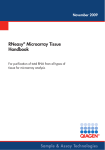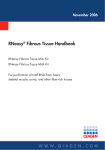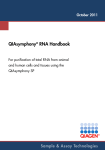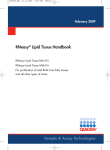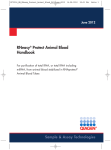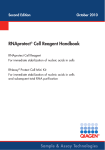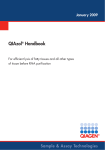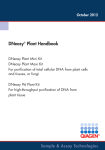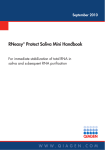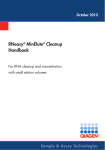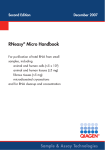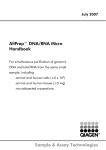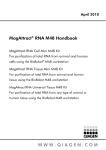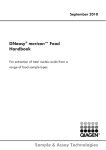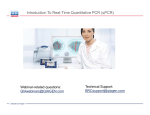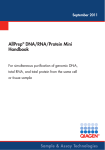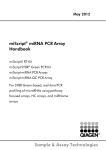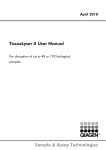Download Sample & Assay Technologies RNeasy® Plus Universal
Transcript
September 2010 RNeasy® Plus Universal Handbook RNeasy Plus Universal Mini Kit RNeasy Plus Universal Midi Kit For purification of total RNA from all types of tissue Sample & Assay Technologies QIAGEN Sample and Assay Technologies QIAGEN is the leading provider of innovative sample and assay technologies, enabling the isolation and detection of contents of any biological sample. Our advanced, high-quality products and services ensure success from sample to result. QIAGEN sets standards in: Purification of DNA, RNA, and proteins Nucleic acid and protein assays microRNA research and RNAi Automation of sample and assay technologies Our mission is to enable you to achieve outstanding success and breakthroughs. For more information, visit www.qiagen.com. Contents Kit Contents 4 Storage 5 Product Use Limitations 5 Product Warranty and Satisfaction Guarantee 5 Technical Assistance 5 Quality Control 6 Safety Information 6 Introduction 8 Principle and procedure 8 Equipment and Reagents to Be Supplied by User 11 Important Notes 12 Determining the amount of starting material 12 Handling and storing starting material 13 Disrupting and homogenizing starting material 14 Protocols Purification of Total RNA Using the RNeasy Plus Universal Mini Kit 16 Purification of Total RNA Using the RNeasy Plus Universal Midi Kit 22 Troubleshooting Guide 27 Appendix A: General Remarks on Handling RNA 31 Appendix B: Storage, Quantification, and Determination of Quality of RNA 33 Appendix C: Purification of Total RNA Containing miRNA Using the RNeasy Plus Universal Mini Kit 36 Appendix D: Purification of Total RNA Containing miRNA Using the RNeasy Plus Universal Midi Kit 38 Ordering Information 40 RNeasy Plus Universal Handbook 09/2010 3 Kit Contents RNeasy Plus Universal Kit Mini (50) Midi (10) Catalog no. 73404 73442 Number of preps 50 10 RNeasy Mini Spin Columns (pink) (each in a 2 ml Collection Tube) 50 – RNeasy Midi Spin Columns (pink) (each in a 15 ml Collection Tube) – 10 Collection Tubes (1.5 ml) 50 – Collection Tubes (2 ml) 50 – Collection Tubes (15 ml) – 10 50 ml 50 ml gDNA Eliminator Solution 8 ml 8 ml Buffer RWT*† (concentrate) 15 ml 15 ml Buffer RPE‡ (concentrate) 11 ml 11 ml RNase-Free Water 10 ml 10 ml 1 1 QIAzol® Lysis Reagent* Handbook * Contains a guanidine salt. Not compatible with disinfectants containing bleach. See page 6 for safety information. † Buffer RWT is supplied as a concentrate. Before using for the first time, add 2 volumes of ethanol (96–100%) as indicated on the bottle to obtain a working solution. ‡ Buffer RPE is supplied as a concentrate. Before using for the first time, add 4 volumes of ethanol (96–100%) as indicated on the bottle to obtain a working solution. Note: QIAzol Lysis Reagent is delivered separately. 4 RNeasy Plus Universal Handbook 09/2010 Storage RNeasy Plus Universal Kits should be stored dry at room temperature (15–25°C). All components are stable for at least 9 months under these conditions. QIAzol Lysis Reagent can be stored at room temperature or at 2–8°C. Product Use Limitations RNeasy Plus Universal Kits are intended for molecular biology applications. These products are not intended for the diagnosis, treatment, or prevention of a disease. All due care and attention should be exercised in the handling of the products. We recommend all users of QIAGEN® products to adhere to the NIH guidelines that have been developed for recombinant DNA experiments, or to other applicable guidelines. Product Warranty and Satisfaction Guarantee QIAGEN guarantees the performance of all products in the manner described in our product literature. The purchaser must determine the suitability of the product for its particular use. Should any product fail to perform satisfactorily due to any reason other than misuse, QIAGEN will replace it free of charge or refund the purchase price. We reserve the right to change, alter, or modify any product to enhance its performance and design. If a QIAGEN product does not meet your expectations, simply call your local Technical Service Department or distributor. We will credit your account or exchange the product — as you wish. Separate conditions apply to QIAGEN scientific instruments, service products, and to products shipped on dry ice. Please inquire for more information. A copy of QIAGEN terms and conditions can be obtained on request, and is also provided on the back of our invoices. If you have questions about product specifications or performance, please call QIAGEN Technical Services or your local distributor (see back cover or visit www.qiagen.com). Technical Assistance At QIAGEN, we pride ourselves on the quality and availability of our technical support. Our Technical Service Departments are staffed by experienced scientists with extensive practical and theoretical expertise in sample and assay technologies and the use of QIAGEN products. If you have any questions or experience any difficulties regarding RNeasy Plus Universal Kits or QIAGEN products in general, please do not hesitate to contact us. RNeasy Plus Universal Handbook 09/2010 5 QIAGEN customers are a major source of information regarding advanced or specialized uses of our products. This information is helpful to other scientists as well as to the researchers at QIAGEN. We therefore encourage you to contact us if you have any suggestions about product performance or new applications and techniques. For technical assistance and more information, please see our Technical Support Center at www.qiagen.com/Support or call one of the QIAGEN Technical Service Departments or local distributors (see back cover or visit www.qiagen.com). Quality Control In accordance with QIAGEN’s ISO-certified Quality Management System, each lot of RNeasy Universal Kits is tested against predetermined specifications to ensure consistent product quality. Safety Information When working with chemicals, always wear a suitable lab coat, disposable gloves, and protective goggles. For more information, please consult the appropriate material safety data sheets (MSDSs). These are available online in convenient and compact PDF format at www.qiagen.com/Support/MSDS.aspx where you can find, view, and print the MSDS for each QIAGEN kit and kit component. CAUTION: DO NOT add bleach or acidic solutions directly to the sample-preparation waste QIAzol Lysis Reagent and Buffer RWT contain guanidine thiocyanate. Guanidine salts can form highly reactive compounds when combined with bleach. If liquid containing these buffers is spilt, clean with suitable laboratory detergent and water. If the spilt liquid contains potentially infectious agents, clean the affected area first with laboratory detergent and water, and then with 1% (v/v) sodium hypochlorite. 6 RNeasy Plus Universal Handbook 09/2010 The following risk and safety phrases apply to the components of RNeasy Plus Universal Kits. QIAzol Lysis Reagent Contains phenol, guanidine thiocyanate: toxic, corrosive. Risk and safety phrases:* R23/24/25-32-34-48/20/21/22-68, S24/25-26-36/37/39-45 gDNA Eliminator Solution Contains cetrimonium bromide: dangerous for the environment. Risk and safety phrases:* R52/53 Buffer RWT Contains guanidine thiocyanate: harmful. Risk and safety phrases:* R20/21/2232, S13-26-36-46 24-hour emergency information Emergency medical information in English, French, and German can be obtained 24 hours a day from: Poison Information Center Mainz, Germany Tel: +49-6131-19240 * R20/21/22: Harmful by inhalation, in contact with skin, and if swallowed; R23/24/25: Toxic by inhalation, in contact with skin, and if swallowed; R32: Contact with acids liberates very toxic gas; R34: Causes burns; R48/20/21/22: Harmful: danger of serious damage to health by prolonged exposure through inhalation, in contact with skin, and if swallowed; R52/53: Harmful to aquatic organisms and may cause long-term adverse effects to the aquatic environment; R68: Possible risks of irreversible effects; S13: Keep away from food, drink, and animal feeding stuffs; S24/25: Avoid contact with skin and eyes; S26: In case of contact with eyes, rinse immediately with plenty of water and seek medical advice; S36: Wear suitable protective clothing: S36/37/39: Wear suitable protective clothing, gloves, and eye/face protection; S45: In case of accident or if you feel unwell, seek medical advice immediately (show the label where possible); S46: If swallowed, seek medical advice immediately and show container or label. RNeasy Plus Universal Handbook 09/2010 7 Introduction RNeasy Plus Universal Kits are designed for lysis of all kinds of tissues and subsequent purification of high-quality total RNA. gDNA Eliminator Solution effectively removes genomic DNA contamination eliminating the need for DNase digestion. It also significantly improves separation of DNA into the interphase. The RNeasy Plus Universal protocol is easy to follow and, compared to phenol/chloroform treatment with a subsequent cleanup procedure, much faster and more efficient with better RNA purity and yield. QIAGEN also provides a wide range of other kits for purification of total RNA from different sample sources (visit www.qiagen.com/RNA). Principle and procedure RNeasy Plus Universal Kits integrate phenol/guanidine-based sample lysis and silica-membrane purification of total RNA. QIAzol Lysis Reagent, included in the kits, is a monophasic solution of phenol and guanidine thiocyanate, designed to facilitate lysis of all kinds of tissues and inhibit RNases. The high lysis efficiency of the reagent and the subsequent removal of contaminants by organic phase extraction enable use of larger amounts of tissue with RNeasy spin columns: RNeasy Plus Universal Mini Kit — up to 50 mg of tissue (or up to 100 mg of brain or adipose tissue) per RNeasy Mini spin column* RNeasy Plus Universal Midi Kit — up to 250 mg of tissue (or up to 500 mg of brain or adipose tissue) per RNeasy Midi spin column* Tissue samples are homogenized in QIAzol Lysis Reagent. After addition of gDNA Eliminator Solution and chloroform, the homogenate is separated into aqueous and organic phases by centrifugation. RNA partitions to the upper, aqueous phase, while DNA partitions to the interphase and proteins to the lower, organic phase or the interphase. The upper, aqueous phase is collected, and RNA is purified using RNeasy spin columns. The steps of the RNA purification procedure differ depending on the kit format. The upper, aqueous phase is mixed with ethanol to provide appropriate binding conditions and applied to an RNeasy Mini spin column. Total RNA binds to the spin column membrane, and phenol and other contaminants are efficiently washed away. High-quality RNA is then eluted in RNase-free water (see flowchart, page 10). The standard protocols for RNeasy Plus Universal Kits (pages 16 and 22) allow purification of all RNA molecules longer than 200 nucleotides. The procedure provides an enrichment for mRNA, since most RNAs <200 nucleotides (such as 5.8S rRNA, 5S rRNA, and tRNAs, which together comprise 15–20% of total * To ensure optimal RNA yields, the binding capacity of the RNeasy spin column must not be exceeded. For details, see the individual protocols. 8 RNeasy Plus Universal Handbook 09/2010 RNA) are selectively excluded. The size distribution of the purified RNA is comparable to that obtained by centrifugation through a CsCl gradient or cushion, where small RNAs do not sediment efficiently. For purification of total RNA containing small RNAs such as microRNA (miRNA) using the RNeasy Plus Universal Mini Kit, see Appendix C (page 36). Information about purification of total RNA containing small RNAs such as miRNA using the RNeasy Plus Universal Midi Kit is provided in Appendix D (page 38). QIAGEN also provides miRNeasy Kits for purification of miRNA, either in a total RNA fraction or in a fraction enriched in small RNAs. miRNeasy Kits are available in both spin-column and 96-well formats. For more details, visit www.qiagen.com/miRNA. RNeasy Plus Universal Handbook 09/2010 9 10 RNeasy Plus Universal Handbook 09/2010 Equipment and Reagents to Be Supplied by User When working with chemicals, always wear a suitable lab coat, disposable gloves, and protective goggles. For more information, consult the appropriate material safety data sheets (MSDSs), available from the product supplier. Chloroform Ethanol (70% and 96–100%)* Sterile, RNase-free pipet tips For stabilization of RNA in tissues (see page 13): RNAlater® RNA Stabilization Reagent or Allprotect Tissue Reagent (see ordering information, page 40) or liquid nitrogen and dry ice Users of RNeasy Plus Universal Mini Kit 1.5 ml or 2 ml microcentrifuge tubes Microcentrifuge(s) (with rotor for 2 ml tubes) for centrifugation at 4°C and at room temperature (15–25°C) Equipment for tissue disruption and homogenization (see page 14): we recommend the TissueRuptor®, the TissueLyser LT, or the TissueLyser II (see ordering information, page 41) Users of RNeasy Plus Universal Midi Kit 10–15 ml centrifuge tubes Laboratory centrifuge(s) (capable of 5000 x g) for centrifugation at 4°C and at room temperature (15–25°C)† Equipment for tissue disruption and homogenization (see page 14): we recommend the TissueRuptor (see ordering information, page 41) * Do not use denatured alcohol, which contains other substances such as methanol or methylethylketone. † All centrifugation steps are carried out in a conventional laboratory centrifuge (e.g., QIAGEN 96-Well-Plate Centrifugation System; please inquire) with a swinging bucket rotor for 15 ml centrifuge tubes. The maximum speed of 3500–5000 rpm corresponds to 3000–5000 x g for most rotors. RNeasy Midi spin columns fit into 15 ml collection tubes supplied with the kit. These fit into the rotor of almost every standard laboratory centrifuge available. In the unlikely event that the tubes do not fit, RNeasy Midi spin columns can also be inserted into different 12–15 ml RNase-free glass or polypropylene tubes. RNeasy Plus Universal Handbook 09/2010 11 Important Notes Determining the amount of starting material It is essential to use the correct amount of starting material in order to obtain optimal RNA yield and purity. The maximum amount that can be used is determined by: The type of tissue and its RNA content The volume of QIAzol Lysis Reagent required for efficient lysis The RNA binding capacity of the RNeasy spin column When processing samples containing high amounts of RNA, less than the maximum amount of starting material shown in Table 1 should be used, so that the RNA binding capacity of the RNeasy spin column is not exceeded. When processing samples containing low amounts of RNA, the maximum amount of starting material shown in Table 1 can be used. However, even though the RNA binding capacity of the RNeasy spin column is not reached, the maximum amount of starting material must not be exceeded. Otherwise, lysis will be incomplete and cellular debris may interfere with the binding of RNA to the RNeasy spin column membrane, resulting in lower RNA yield and purity. More information on using the correct amount of starting material is given in the protocols. Table 2 shows expected RNA yields from various sources. Table 1. RNeasy spin column specifications RNeasy Mini spin column RNeasy Midi spin column Maximum binding capacity 100 μg RNA 1 mg RNA Maximum loading volume 700 μl 4 ml RNA >200 nucleotides RNA >200 nucleotides 30 μl 150 μl ≤50 mg ≤250 mg Specification RNA size distribution Minimum elution volume Maximum amount of starting tissue Note: If the binding capacity of the RNeasy spin column is exceeded, RNA yields will not be consistent and may be reduced. If lysis of the starting material is incomplete, RNA yields will be lower than expected, even if the binding capacity of the RNeasy spin column is not exceeded. 12 RNeasy Plus Universal Handbook 09/2010 Table 2. Typical yields of total RNA with RNeasy Plus Universal Kits Mouse/rat tissue (10 mg) Yield of total RNA (μg)* Adipose tissue 0.5–2.5 Brain 5–20 Heart 5–25 Intestine 10–60 Kidney 5–40 Liver 15–80 Lung 5–15 Muscle 5–35 Skin 2–5 Spleen 15–100 * Amounts can vary due to factors such as species and developmental stage (especially with adipose tissues, large variations are possible due to developmental stage and location of the tissue). Since the RNeasy procedure enriches for mRNA and other RNA species >200 nucleotides, the total RNA yield does not include 5S rRNA, tRNA, and other low-molecularweight RNAs, which make up 15–20% of total cellular RNA. Handling and storing starting material RNA in harvested tissue is not protected until the sample is treated with RNAlater RNA Stabilization Reagent, flash-frozen, or disrupted and homogenized in the presence of RNase-inhibiting or denaturing reagents. Otherwise, unwanted changes in the gene expression profile will occur. It is therefore important that tissue samples are immediately frozen in liquid nitrogen and stored at –70°C, or immediately immersed in RNAlater RNA Stabilization Reagent at room temperature (15–25°C). An alternative to RNAlater RNA Stabilization Reagent is Allprotect Tissue Reagent, which provides immediate stabilization of DNA, RNA, and protein in tissue samples at room temperature. Note: RNAlater RNA Stabilization Reagent cannot be used to stabilize RNA in adipose tissue due to the high abundance of fat, but can be used to stabilize RNA in other fatty tissues such as brain. Allprotect Tissue Reagent can stabilize adipose and brain tissue. The procedures for tissue harvesting and RNA protection should be carried out as quickly as possible. Frozen tissue samples should not be allowed to thaw during handling or weighing. RNeasy Plus Universal Handbook 09/2010 13 Disrupting and homogenizing starting material Efficient disruption and homogenization of the starting material is an absolute requirement for all total RNA purification procedures. Disruption and homogenization are 2 distinct steps: Disruption: Complete disruption of plasma membranes of cells and organelles is absolutely required to release all the RNA contained in the sample. Incomplete disruption results in significantly reduced RNA yields. Homogenization: Homogenization is necessary to reduce the viscosity of the lysates produced by disruption. Homogenization shears highmolecular-weight genomic DNA and other high-molecular-weight cellular components to create a homogeneous lysate. Incomplete homogenization results in inefficient binding of RNA to the RNeasy spin column membrane and therefore significantly reduced RNA yields. Disruption and homogenization of tissue samples can be carried out rapidly and efficiently using either the TissueRuptor (for processing samples individually) or a TissueLyser system (for processing multiple samples simultaneously). Disruption and homogenization with TissueRuptor and TissueLyser systems generally results in higher RNA yields than with other methods. Disruption and homogenization using the TissueRuptor The TissueRuptor is a rotor–stator homogenizer that thoroughly disrupts and simultaneously homogenizes single tissue samples in the presence of lysis buffer in 15–90 seconds, depending on the toughness and size of the sample. The blade of the TissueRuptor disposable probe rotates at a very high speed, causing the sample to be disrupted and homogenized by a combination of turbulence and mechanical shearing. For guidelines on using the TissueRuptor, refer to the TissueRuptor Handbook. For other rotor–stator homogenizers, refer to suppliers’ guidelines. Disruption and homogenization using TissueLyser systems In bead-milling, tissues can be disrupted by rapid agitation in the presence of beads and lysis buffer. Disruption and simultaneous homogenization occur by the shearing and crushing action of the beads as they collide with the cells. Two bead mills are available from QIAGEN: the TissueLyser LT for low- to mediumthroughput disruption, and the TissueLyser II for medium- to high-throughput disruption. The TissueLyser LT disrupts and homogenizes up to 12 samples at the same time. The instrument needs to be used in combination with the TissueLyser LT Adapter, which holds 12 x 2 ml microcentrifuge tubes containing stainless steel beads of 5 mm or 7 mm mean diameter. For guidelines on using the TissueLyser LT, refer to the TissueLyser LT Handbook. 14 RNeasy Plus Universal Handbook 09/2010 The TissueLyser II disrupts and homogenizes up to 48 tissue samples simultaneously when used in combination with the TissueLyser Adapter Set 2 x 24, which holds 48 x 2 ml microcentrifuge tubes containing stainless steel beads of 5 mm mean diameter. For guidelines on using the TissueLyser II, refer to the TissueLyser Handbook. If using other bead mills for sample disruption and homogenization, refer to suppliers’ guidelines. Note: Tungsten carbide beads react with QIAzol Lysis Reagent and must not be used to disrupt and homogenize tissues. The TissueLyser II can also disrupt and homogenize up to 192 tissue samples simultaneously when used in combination with the TissueLyser Adapter Set 2 x 96, which holds 192 x 1.2 ml microtubes containing stainless steel beads of 5 mm mean diameter. In this case, we recommend using the RNeasy 96 Universal Tissue Kit, which provides high-throughput RNA purification from all types of tissue in 96-well format. For ordering information, see page 40. RNeasy Plus Universal Handbook 09/2010 15 Protocol: Purification of Total RNA Using the RNeasy Plus Universal Mini Kit Determining the correct amount of starting material It is essential to use the correct amount of tissue in order to obtain optimal RNA yield and purity. With the RNeasy Plus Universal Mini Kit, a maximum of 50 mg tissue can generally be processed. Using this amount, the RNA binding capacity of the RNeasy Mini spin column and the lysing capacity of QIAzol Lysis Reagent will not be exceeded. For brain or adipose tissue, a maximum of 100 mg tissue can generally be used. For tissues with high RNA content such as liver, spleen, and thymus, we recommend using no more than 30 mg tissue to ensure optimal RNA yields and to avoid exceeding the binding capacity of the RNA spin column. Average RNA yields from various tissues are given in Table 2 (page 13). If there is no information about the nature of your starting material, we recommend starting with no more than 30 mg tissue. Depending on RNA yield and purity, it may be possible to use up to 100 mg tissue in subsequent preparations. Do not overload the RNeasy spin column, as this will significantly reduce RNA yield and quality. Weighing tissue is the most accurate way to quantify the amount of starting material. As a guide, a 4 mm cube (64 mm3) of most animal tissues weighs 70–85 mg. Important points before starting If using RNeasy Plus Universal Kits for the first time, read “Important Notes” (page 12). If working with RNA for the first time, read Appendix A (page 31). If using a TissueRuptor or TissueLyser system, ensure that you are familiar with operating it by referring to the supplied user manual (operating instructions) and handbook. To freeze tissue for long-term storage (several months), flash-freeze in liquid nitrogen, and immediately transfer to –70°C. Do not allow tissues to thaw during weighing or handling prior to disruption in QIAzol Lysis Reagent. Homogenized tissue lysates from step 3 can also be stored at –70°C for several months. Incubate frozen lysates at 37°C in a water bath until completely thawed and salts are dissolved before continuing with step 4. Avoid prolonged incubation, which may compromise RNA integrity. Generally, DNase digestion is not required since integrated QIAzol, gDNA Eliminator Solution, and RNeasy technologies efficiently remove most of the genomic DNA contamination without DNase treatment. For real-time two- 16 RNeasy Plus Universal Handbook 09/2010 step RT-PCR applications, further DNA removal can be achieved using the QuantiTect® Reverse Transcription Kit, which provides cDNA synthesis with integrated removal of genomic DNA contamination (see ordering information, page 42). QIAzol Lysis Reagent and Buffer RWT contain a guanidine salt and are therefore not compatible with disinfecting reagents containing bleach. See page 6 for safety information. Except for phase separation (step 8), all protocol and centrifugation steps should be performed at room temperature (15–25°C). During the procedure, work quickly. Things to do before starting Buffer RWT is supplied as a concentrate. Before using for the first time, add 2 volumes of ethanol (96–100%) as indicated on the bottle to obtain a working solution. Buffer RPE is supplied as a concentrate. Before using for the first time, add 4 volumes of ethanol (96–100%) as indicated on the bottle to obtain a working solution. Procedure 1. If using a TissueLyser system, add one stainless steel bead (5 mm mean diameter) per 2 ml microcentrifuge tube (not supplied). If working with tissues that are not stabilized in RNAlater or Allprotect Reagent, place the tubes on dry ice. Note: When disrupting tough or very tough samples with the TissueLyser LT, we recommend using one or two 7 mm stainless steel beads. 2. Excise the tissue sample from the animal or remove it from storage. Determine the amount of tissue. Do not use more than 50 mg tissue or more than 100 mg brain or adipose tissue. Proceed immediately to step 3. Weighing tissue is the most accurate way to determine the amount. If the tissue sample was stored in RNAlater or Allprotect Reagent, remove it from the reagent using forceps and be sure to remove any excess reagent or crystals that may have formed. RNA in harvested tissues is not protected until the tissues are treated with RNAlater or Allprotect Reagent, flash-frozen, or disrupted and homogenized in step 3. Frozen tissues should not be allowed to thaw during handling. The relevant procedures should be carried out as quickly as possible. RNeasy Plus Universal Handbook 09/2010 17 3. Disrupt the tissue and homogenize the lysate using the TissueRupter (follow step 3a), TissueLyser LT (follow step 3b), or TissueLyser II (follow step 3c). See “Disrupting and homogenizing starting material”, page 14, for more details on disruption and homogenization. Note: Incomplete homogenization leads to significantly reduced RNA yields and can cause clogging of the RNeasy spin column. Homogenization with TissueRupter and TissueLyser systems generally results in higher RNA yields than with other methods. 3a. Disruption and homogenization using the TissueRuptor: Place the tissue in a suitably sized vessel containing 900 μl QIAzol Lysis Reagent. Note: Use a suitably sized vessel with sufficient extra headspace to accommodate foaming, which may occur during homogenization. Generally, round-bottomed tubes allow more efficient disruption and homogenization than conical-bottomed tubes. Place the tip of the disposable probe into the vessel and operate the TissueRuptor at full speed until the lysate is uniformly homogeneous (usually 20–40 s). Proceed to step 4. Note: To avoid damage to the TissueRuptor and disposable probe during operation, make sure the tip of the probe remains submerged in the buffer. Foaming may occur during homogenization, especially of brain tissue. If this occurs, let the homogenate stand at room temperature for 2–3 min until the foam subsides before continuing with the procedure. 3b. Disruption and homogenization using the TissueLyser LT: Keep the tubes prepared in step 1 on dry ice for at least 15 min (however, keep the insert of the TissueLyser LT Adapter at room temperature). Then place the tissues in the tubes, and keep the tubes on dry ice for another 15 min. If working with RNAlater or Allprotect stabilized tissues, it is not necessary to place the tubes on dry ice. Place the tubes in the insert of the TissueLyser LT Adapter, and incubate at room temperature for 2 min. Then immediately add 900 μl QIAzol Lysis Reagent per tube. Do not incubate for longer than 2 min, otherwise frozen tissues will thaw, resulting in potential RNA degradation. Place the tubes in the TissueLyser LT Adapter. 18 RNeasy Plus Universal Handbook 09/2010 Operate the TissueLyser LT for 2–5 min at 50 Hz. The time depends on the tissue being processed and can be extended until the tissue is completely homogenized. Carefully pipet the lysates into new microcentrifuge tubes (not supplied). Proceed to step 4. Do not reuse the stainless steel beads. 3c. Disruption and homogenization using the TissueLyser II: Place the tissues in the tubes prepared in step 1. If the tubes were stored on dry ice, place them at room temperature. Then immediately add 900 μl QIAzol Lysis Reagent per tube. Place the tubes in the TissueLyser Adapter Set 2 x 24. Operate the TissueLyser for 2 min at 20 Hz. The time depends on the tissue being processed and can be extended until the tissue is completely homogenized. Disassemble the adapter set, rotate the rack of tubes so that the tubes nearest to the TissueLyser II are now outermost, and reassemble the adapter set. Operate the TissueLyser for another 2 min at 20 Hz. Rearranging the tubes allows even homogenization. Carefully pipet the lysates into new microcentrifuge tubes (not supplied). Proceed to step 4. Do not reuse the stainless steel beads. 4. Place the tube containing the homogenate on the benchtop at room temperature (15–25°C) for 5 min. This step promotes dissociation of nucleoprotein complexes. 5. Add 100 μl gDNA Eliminator Solution. Securely cap the tube containing the homogenate, and shake it vigorously for 15 s. Addition of gDNA Eliminator Solution will effectively reduce genomic DNA contamination of the aqueous phase, making further treatment with DNase unnecessary. 6. Add 180 μl chloroform. Securely cap the tube containing the homogenate, and shake it vigorously for 15 s. Thorough mixing is important for subsequent phase separation. 7. Place the tube containing the homogenate on the benchtop at room temperature for 2–3 min. RNeasy Plus Universal Handbook 09/2010 19 8. Centrifuge at 12,000 x g for 15 min at 4°C. After centrifugation, heat the centrifuge to room temperature (15–25°C) if the same centrifuge will be used in the later steps of this procedure. After centrifugation, the sample separates into 3 phases: an upper, colorless, aqueous phase containing RNA; a white interphase; and a lower, red, organic phase. For tissues with an especially high fat content, an additional, clear phase may be visible below the red, organic phase. The volume of the aqueous phase should be approximately 600 μl. 9. Transfer the upper, aqueous phase (usually 600 μl) to a new microcentrifuge tube (not supplied). 10. Add 1 volume (usually 600 μl) of 70% ethanol, and mix thoroughly by pipetting up and down. Do not centrifuge. Proceed immediately to step 11. Note: The volume of lysate may be less than 600 μl due to loss during homogenization and centrifugation. Precipitates may be visible after addition of ethanol. Resuspend precipitates completely by vigorous shaking, and proceed immediately to step 11. 11. Transfer up to 700 μl of the sample to an RNeasy Mini spin column placed in a 2 ml collection tube (supplied). Close the lid gently, and centrifuge for 15 s at ≥8000 x g (≥10,000 rpm) at room temperature (15–25°C). Discard the flow-through.* Reuse the collection tube in step 12. 12. Repeat step 11 using the remainder of the sample. Discard the flowthrough.* Reuse the collection tube in step 13. 13. Add 700 μl Buffer RWT to the RNeasy spin column. Close the lid gently, and centrifuge for 15 s at ≥8000 x g (≥10,000 rpm) to wash the membrane. Discard the flow-through.* Reuse the collection tube in step 14. After centrifugation, carefully remove the RNeasy spin column from the collection tube so that the column does not contact the flow-through. Be sure to empty the collection tube completely.* Note: Buffer RWT is supplied as a concentrate. Ensure that ethanol is added to Buffer RWT before use (see “Things to do before starting”, page 17). * Flow-through contains QIAzol Lysis Reagent or Buffer RWT and is therefore not compatible with bleach. See page 6 for safety information. 20 RNeasy Plus Universal Handbook 09/2010 14. Add 500 μl Buffer RPE to the RNeasy spin column. Close the lid gently, and centrifuge for 15 s at ≥8000 x g (≥10,000 rpm) to wash the membrane. Discard the flow-through. Reuse the collection tube in step 15. Note: Buffer RPE is supplied as a concentrate. Ensure that ethanol is added to Buffer RPE before use (see “Things to do before starting”, page 17). 15. Add 500 μl Buffer RPE to the RNeasy spin column. Close the lid gently, and centrifuge for 2 min at ≥8000 x g (≥10,000 rpm) to wash the membrane. The long centrifugation dries the spin column membrane, ensuring that no ethanol is carried over during RNA elution. Residual ethanol may interfere with downstream reactions. Note: After centrifugation, carefully remove the RNeasy spin column from the collection tube so that the column does not contact the flow-through. Otherwise, carryover of ethanol will occur. 16. Optional: Place the RNeasy spin column in a new 2 ml collection tube (supplied), and discard the old collection tube with the flowthrough. Close the lid gently, and centrifuge at full speed for 1 min. Perform this step to eliminate any possible carryover of Buffer RPE, or if residual flow-through remains on the outside of the RNeasy spin column after step 15. 17. Place the RNeasy spin column in a new 1.5 ml collection tube (supplied). Add 30–50 μl RNase-free water directly to the spin column membrane. Close the lid gently. To elute the RNA, centrifuge for 1 min at ≥8000 x g (≥10,000 rpm). 18. Repeat step 17 using another volume of RNase-free water, or using the eluate from step 17 (if high RNA concentration is required). Reuse the collection tube from step 17. If using the eluate from step 17, the RNA yield will be 15–30% less than that obtained using a second volume of RNase-free water, but the final RNA concentration will be higher. RNeasy Plus Universal Handbook 09/2010 21 Protocol: Purification of Total RNA Using the RNeasy Plus Universal Midi Kit Determining the correct amount of starting material It is essential to use the correct amount of tissue in order to obtain optimal RNA yield and purity. With the RNeasy Plus Universal Midi Kit, a maximum of 250 mg tissue can generally be processed. Using this amount, the RNA binding capacity of the RNeasy Midi spin column and the lysing capacity of QIAzol Lysis Reagent will not be exceeded. For brain or adipose tissue, a maximum of 500 mg tissue can generally be used. For tissues with high RNA content such as liver, spleen, and thymus, we recommend using no more than 150 mg tissue to ensure optimal RNA yields and to avoid exceeding the binding capacity of the RNA spin column. Average RNA yields from various tissues are given in Table 2 (page 13). If there is no information about the nature of your starting material, we recommend starting with no more than 150 mg tissue. Depending on RNA yield and purity, it may be possible to use up to 500 mg tissue in subsequent preparations. Do not overload the RNeasy spin column, as this will significantly reduce RNA yield and quality. Weighing tissue is the most accurate way to quantify the amount of starting material. As a guide, a 6 mm cube (216 mm3) of most animal tissues weighs 240–280 mg. Important points before starting If using RNeasy Plus Universal Kits for the first time, read “Important Notes” (page 12). If working with RNA for the first time, read Appendix A (page 31). If using the TissueRuptor, ensure that you are familiar with operating it by referring to the TissueRuptor User Manual and TissueRuptor Handbook. To freeze tissue for long-term storage (several months), flash-freeze in liquid nitrogen, and immediately transfer to –70°C. Do not allow tissues to thaw during weighing or handling prior to disruption in QIAzol Lysis Reagent. Homogenized tissue lysates from step 3 can also be stored at –70°C for several months. Incubate frozen lysates at 37°C in a water bath until completely thawed and salts are dissolved before continuing with step 4. Avoid prolonged incubation, which may compromise RNA integrity. Generally, DNase digestion is not required since integrated QIAzol, gDNA Eliminator Solution, and RNeasy technologies efficiently remove most of the DNA without DNase treatment. For real-time two-step RT-PCR applications, 22 RNeasy Plus Universal Handbook 09/2010 further DNA removal can be achieved using the QuantiTect Reverse Transcription Kit, which provides cDNA synthesis with integrated removal of genomic DNA contamination (see ordering information, page 42). QIAzol Lysis Reagent and Buffer RWT contain a guanidine salt and are therefore not compatible with disinfecting reagents containing bleach. See page 6 for safety information. Except for phase separation (step 8), all protocol and centrifugation steps should be performed at room temperature (15–25°C). During the procedure, work quickly. Things to do before starting Buffer RWT is supplied as a concentrate. Before using for the first time, add 2 volumes of ethanol (96–100%) as indicated on the bottle to obtain a working solution. Buffer RPE is supplied as a concentrate. Before using for the first time, add 4 volumes of ethanol (96–100%) as indicated on the bottle to obtain a working solution. Procedure 1. Excise the tissue sample from the animal or remove it from storage. Determine the amount of tissue. Do not use more than 250 mg tissue or more than 500 mg brain or adipose tissue. Proceed immediately to step 2. Weighing tissue is the most accurate way to determine the amount. If the tissue sample was stored in RNAlater or Allprotect Reagent, remove it from the reagent using forceps and be sure to remove any excess reagent or crystals that may have formed. RNA in harvested tissues is not protected until the tissues are treated with RNAlater or Allprotect Reagent, flash-frozen, or disrupted and homogenized in step 3. Frozen tissues should not be allowed to thaw during handling. The relevant procedures should be carried out as quickly as possible. 2. Place the tissue in a suitably sized vessel containing 5 ml QIAzol Lysis Reagent. Note: Use a suitably sized vessel with sufficient extra headspace to accommodate foaming, which may occur during homogenization. Generally, round-bottomed tubes allow more efficient disruption and homogenization than conical-bottomed tubes. 3. Place the tip of the TissueRuptor disposable probe into the vessel and operate the TissueRuptor at full speed until the lysate is uniformly homogeneous (usually 30–60 s). RNeasy Plus Universal Handbook 09/2010 23 Note: To avoid damage to the TissueRuptor and disposable probe during operation, make sure the tip of the probe remains submerged in the buffer. Note: Incomplete homogenization leads to significantly reduced RNA yields and can cause clogging of the RNeasy spin column. Foaming may occur during homogenization, especially of brain tissue. If this occurs, let the homogenate stand at room temperature for 2–3 min until the foam subsides before continuing with the procedure. 4. Place the tube containing the homogenate on the benchtop at room temperature (15–25°C) for 5 min. This step promotes dissociation of nucleoprotein complexes. 5. Add 500 μl gDNA Eliminator Solution. Securely cap the tube containing the homogenate, and shake it vigorously for 15 s. Addition of gDNA Eliminator Solution will effectively reduce genomic DNA contamination of the aqueous phase, making further treatment with DNase unnecessary. 6. Add 1 ml chloroform. Securely cap the tube containing the homogenate, and shake it vigorously for 15 s. Thorough mixing is important for subsequent phase separation. 7. Place the tube containing the homogenate on the benchtop at room temperature for 2–3 min. 8. Centrifuge at 5000 x g for 15 min at 4°C. After centrifugation, heat the centrifuge to room temperature (15–25°C) if the same centrifuge will be used in the later steps of this procedure. After centrifugation, the sample separates into 3 phases: an upper, colorless, aqueous phase containing RNA; a white interphase; and a lower, red, organic phase. For tissues with an especially high fat content, an additional, clear phase may be visible below the red, organic phase. The volume of the aqueous phase should be approximately 3 ml. 9. Transfer the upper, aqueous phase to a new tube (not supplied). 10. Add 1 volume (usually 3 ml) of 70% ethanol, and mix thoroughly by vortexing. Do not centrifuge. Proceed immediately to step 11. Note: The volume of lysate may be less than 3 ml due to loss during homogenization and centrifugation. Precipitates may be visible after addition of ethanol. Resuspend precipitates completely by vigorous shaking, and proceed immediately to step 11. 24 RNeasy Plus Universal Handbook 09/2010 11. Transfer up to 4 ml of the sample to an RNeasy Midi spin column placed in a 15 ml collection tube (supplied). Close the lid gently, and centrifuge for 5 min at 3000–5000 x g at room temperature (15–25°C). Discard the flow-through.* Reuse the collection tube in step 12. 12. Repeat step 11 using the remainder of the sample (up to 4 ml). Discard the flow-through.* Reuse the collection tube in step 13. 13. Add 4 ml Buffer RWT to the RNeasy spin column. Close the lid gently, and centrifuge for 5 min at 3000–5000 x g to wash the membrane. Discard the flow-through.* Reuse the collection tube in step 14. Note: Buffer RWT is supplied as a concentrate. Ensure that ethanol is added to Buffer RWT before use (see “Things to do before starting”, page 23). 14. Add 2.5 ml Buffer RPE to the RNeasy spin column. Close the lid gently, and centrifuge for 2 min at 3000–5000 x g to wash the membrane. Discard the flow-through. Reuse the collection tube in step 15. Note: Buffer RPE is supplied as a concentrate. Ensure that ethanol is added to Buffer RPE before use (see “Things to do before starting”, page 23). 15. Add 2.5 ml Buffer RPE to the RNeasy spin column. Close the lid gently, and centrifuge for 5 min at 3000–5000 x g to wash the membrane. The long centrifugation dries the spin column membrane, ensuring that no ethanol is carried over during RNA elution. Residual ethanol may interfere with downstream reactions. Note: After centrifugation, carefully remove the RNeasy spin column from the collection tube so that the column does not contact the flow-through. Otherwise, carryover of ethanol will occur. 16. Place the RNeasy spin column in a new 15 ml collection tube (supplied). Add the appropriate volume of RNase-free water (see Table 3, page 26) directly to the spin column membrane. Close the lid gently. To elute the RNA, wait for 1 min and then centrifuge for 3 min at 3000–5000 x g. * Flow-through contains QIAzol Lysis Reagent or Buffer RWT and is therefore not compatible with bleach. See page 6 for safety information. RNeasy Plus Universal Handbook 09/2010 25 Table 3. Volumes of RNase-free water for RNA elution Expected total RNA yield RNase-free water ≤150 μg 150 μl 150 μg – 1 mg 250 μl 17. Repeat step 16 using another volume of RNase-free water, or using the eluate from step 16 (if high RNA concentration is required). Reuse the collection tube from step 16. If using the eluate from step 16, the RNA yield will be 15–30% less than that obtained using a second volume of RNase-free water, but the final RNA concentration will be higher. 26 RNeasy Plus Universal Handbook 09/2010 Troubleshooting Guide This troubleshooting guide may be helpful in solving any problems that may arise. For more information, see also the Frequently Asked Questions page at our Technical Support Center: www.qiagen.com/FAQ/FAQList.aspx. The scientists in QIAGEN Technical Services are always happy to answer any questions you may have about either the information and protocols in this handbook or sample and assay technologies (for contact information, see back cover or visit www.qiagen.com). Comments and suggestions Phases do not separate completely a) No chloroform added or chloroform not pure Make sure to add chloroform that does not contain isoamyl alcohol or other additives. b) Homogenate not sufficiently mixed before centrifugation After addition of chloroform (step 6), the homogenate must be vigorously shaken. If the phases are not well separated, shake the tube vigorously for at least 15 s, and repeat the incubation and centrifugation in steps 7 and 8. c) Organic solvents in samples used for RNA purification Make sure that the starting sample does not contain organic solvents (e.g., ethanol, DMSO), strong buffers, or alkaline reagents. These can interfere with the phase separation. Clogged RNeasy spin column a) Inefficient disruption and/or homogenization See “Disrupting and homogenizing starting material” (page 14) for details on disruption and homogenization methods. Increase g-force and centrifugation time if necessary. In subsequent preparations, reduce the amount of starting material (see page 12 and protocol, page 16 or 22) and/or increase the homogenization time. b) Too much starting material In subsequent preparations, reduce the amount of starting material. It is essential to use the correct amount of starting material (see page 12 and protocol, page 16 or 22). RNeasy Plus Universal Handbook 09/2010 27 Comments and suggestions c) Centrifugation temperature too low Except for phase separation (step 8), all centrifugation steps should be performed at 15–25°C. Some centrifuges may cool to below 20°C even when set at 20°C. This can cause formation of precipitates that can clog the RNeasy spin column. If this happens, set the centrifugation temperature to 25°C. Warm the ethanol-containing lysate to 37°C before transferring to the RNeasy spin column. Low RNA yield a) Insufficient disruption and homogenization See “Disrupting and homogenizing starting material” (page 14) for details on disruption and homogenization methods. b) Too much starting material In subsequent preparations, reduce the amount of starting material. It is essential to use the correct amount of starting material (see page 12 and protocol, page 16 or 22). c) RNA still bound to RNeasy spin column membrane Repeat RNA elution, but incubate the RNeasy spin column on the benchtop for 10 min with RNase-free water before centrifuging. d) Centrifugation temperature too low Except for phase separation (step 8), all centrifugation steps should be performed at 15–25°C. Some centrifuges may cool to below 20°C even when set at 20°C. This can cause formation of precipitates that can clog the RNeasy spin column. If this happens, set the centrifugation temperature to 25°C. Warm the ethanol-containing lysate to 37°C before transferring to the RNeasy spin column. Low or no recovery of RNA (RNeasy Plus Universal Mini Kit) RNase-free water incorrectly dispensed Add RNase-free water to the center of the RNeasy spin column membrane to ensure that the membrane is completely covered. Low A260/A280 value a) Not enough QIAzol Lysis Reagent used for homogenization 28 In subsequent preparations, reduce the amount of starting material and/or increase the volume of QIAzol Lysis Reagent and the homogenization time. RNeasy Plus Universal Handbook 09/2010 Comments and suggestions b) Sample not incubated for 5 min after homogenization Place the sample at room temperature (15–25°C) for 5 min after homogenization, as indicated in the protocol (step 4). This step is important to promote dissociation of nucleoprotein complexes. c) Water used to dilute RNA for A260/A280 measurement Use 10 mM Tris·Cl, pH 7.5, not RNase-free water, to dilute the sample before measuring purity (see Appendix B, page 33). RNA degraded a) Inappropriate handling of starting material For frozen tissue samples, ensure that they were flash-frozen immediately in liquid nitrogen and properly stored at –70°C. Perform the RNeasy procedure quickly, especially the first few steps. See Appendix A (page 31) and “Handling and storing starting material” (page 13). b) RNase contamination Although all RNeasy buffers have been tested and are guaranteed RNase-free, RNases can be introduced during use. Be certain not to introduce any RNases during the RNeasy procedure or later handling. See Appendix A (page 31) for general remarks on handling RNA. Do not put RNA samples into a vacuum dryer that has been used in DNA preparation where RNases may have been used. DNA contamination in downstream experiments a) Phase separation performed at too high a temperature The phase separation (step 8) should be performed at 4°C to allow optimal phase separation and removal of genomic DNA from the aqueous phase. Make sure that the centrifuge does not heat above 10°C during the centrifugation. b) Interphase contamination of aqueous phase Contamination of the aqueous phase with the interphase results in an increased DNA content in the RNA eluate. Make sure to transfer the aqueous phase without interphase contamination. RNeasy Plus Universal Handbook 09/2010 29 Comments and suggestions c) Not enough QIAzol Lysis Reagent used for homogenization In subsequent preparations, reduce the amount of starting material and/or increase the volume of QIAzol Lysis Reagent and the homogenization time. d) Organic solvents in samples used for RNA purification Make sure that the starting sample does not contain organic solvents (e.g., ethanol, DMSO), strong buffers, or alkaline reagents. These can interfere with the phase separation. e) No gDNA Eliminator Solution added before phase separation In subsequent preparations, add the appropriate amount of gDNA Eliminator Solution. f) Lysate mixed with chloroform by vortexing Mix lysate and chloroform by shaking vigorously. Do not vortex the tubes. RNA does not perform well in downstream experiments a) Salt carryover during elution Ensure that Buffer RPE is at 20–30°C. b) Ethanol carryover During the second wash with Buffer RPE, be sure to dry the RNeasy spin column membrane by centrifuging at ≥8000 x g (≥10,000 rpm) for 2 min at 15–25°C (RNeasy Plus Universal Mini Kit, step 15 of protocol) or at 3000–5000 x g for 5 min at 15–25°C (RNeasy Plus Universal Midi Kit, step 14 of protocol). After centrifugation, carefully remove the column from the collection tube so that the column does not contact the flow-through. Otherwise, carryover of ethanol will occur. To eliminate any chance of possible ethanol carryover with the RNeasy Plus Universal Mini Kit, place the RNeasy Mini spin column in a new 2 ml collection tube and perform the optional 1-min centrifugation step as described in step 16 of the protocol. 30 RNeasy Plus Universal Handbook 09/2010 Appendix A: General Remarks on Handling RNA Handling RNA Ribonucleases (RNases) are very stable and active enzymes that generally do not require cofactors to function. Since RNases are difficult to inactivate and even minute amounts are sufficient to destroy RNA, do not use any plasticware or glassware without first eliminating possible RNase contamination. Great care should be taken to avoid inadvertently introducing RNases into the RNA sample during or after the purification procedure. In order to create and maintain an RNase-free environment, the following precautions must be taken during pretreatment and use of disposable and nondisposable vessels and solutions while working with RNA. General handling Proper microbiological, aseptic technique should always be used when working with RNA. Hands and dust particles may carry bacteria and molds and are the most common sources of RNase contamination. Always wear latex or vinyl gloves while handling reagents and RNA samples to prevent RNase contamination from the surface of the skin or from dusty laboratory equipment. Change gloves frequently and keep tubes closed whenever possible. Keep purified RNA on ice when aliquots are pipetted for downstream applications. To remove RNase contamination from bench surfaces, nondisposable plasticware, and laboratory equipment (e.g., pipets and electrophoresis tanks), use of RNaseKiller (cat. no 2500080) from 5 PRIME (www.5prime.com) is recommended. RNase contamination can alternatively be removed using general laboratory reagents. To decontaminate plasticware, rinse with 0.1 M NaOH, 1 mM EDTA* followed by RNase-free water (see ”Solutions”, page 32), or rinse with chloroform* if the plasticware is chloroform-resistant. To decontaminate electrophoresis tanks, clean with detergent (e.g., 0.5% SDS),* rinse with RNase-free water, rinse with ethanol (if the tanks are ethanolresistant), and allow to dry. Disposable plasticware The use of sterile, disposable polypropylene tubes is recommended throughout the procedure. These tubes are generally RNase-free and do not require pretreatment to inactivate RNases. * When working with chemicals, always wear a suitable lab coat, disposable gloves, and protective goggles. For more information, consult the appropriate material safety data sheets (MSDSs), available from the product supplier. RNeasy Plus Universal Handbook 09/2010 31 Glassware Glassware should be treated before use to ensure that it is RNase-free. Glassware used for RNA work should be cleaned with a detergent,* thoroughly rinsed, and oven baked at 240°C for at least 4 hours (overnight, if more convenient) before use. Autoclaving alone will not fully inactivate many RNases. Alternatively, glassware can be treated with DEPC* (diethyl pyrocarbonate), as described in “Solutions” below. Solutions Solutions (water and other solutions) should be treated with 0.1% DEPC. DEPC is a strong, but not absolute, inhibitor of RNases. It is commonly used at a concentration of 0.1% to inactivate RNases on glass or plasticware or to create RNase-free solutions and water. DEPC inactivates RNases by covalent modification. Add 0.1 ml DEPC to 100 ml of the solution to be treated and shake vigorously to bring the DEPC into solution. Let the solution incubate for 12 hours at 37°C. Autoclave for 15 minutes to remove any trace of DEPC. DEPC will react with primary amines and cannot be used directly to treat Tris* buffers. DEPC is highly unstable in the presence of Tris buffers and decomposes rapidly into ethanol and CO2. When preparing Tris buffers, treat water with DEPC first, and then dissolve Tris to make the appropriate buffer. Trace amounts of DEPC will modify purine residues in RNA by carbethoxylation. Carbethoxylated RNA is translated with very low efficiency in cell-free systems. However, its ability to form DNA:RNA or RNA:RNA hybrids is not seriously affected unless a large fraction of the purine residues have been modified. Residual DEPC must always be eliminated from solutions or vessels by autoclaving or heating to 100°C for 15 minutes. Note: RNeasy buffers are guaranteed RNase-free without using DEPC treatment and are therefore free of any DEPC contamination. * When working with chemicals, always wear a suitable lab coat, disposable gloves, and protective goggles. For more information, consult the appropriate material safety data sheets (MSDSs), available from the product supplier. 32 RNeasy Plus Universal Handbook 09/2010 Appendix B: Storage, Quantification, and Determination of Quality of RNA Storage of RNA Purified RNA may be stored at –20°C or –70°C in RNase-free water. Under these conditions, no degradation of RNA is detectable after 1 year. Quantification of RNA The concentration of RNA should be determined by measuring the absorbance at 260 nm (A260) in a spectrophotometer (see “Spectrophotometric quantification of RNA” below). For small amounts of RNA, however, it may be difficult to determine amounts photometrically. Small amounts of RNA can be quantified using the QIAxcel® system (www.qiagen.com/QIAxcel) or Agilent® 2100 Bioanalyzer, quantitative RT-PCR, or fluorometric quantification. Spectrophotometric quantification of RNA To ensure significance, A260 readings should be greater than 0.15. An absorbance of 1 unit at 260 nm corresponds to 44 μg of RNA per ml (A260=1 → 44 μg/ml). This relation is valid only for measurements at a neutral pH. Therefore, if it is necessary to dilute the RNA sample, this should be done in a buffer with neutral pH.* As discussed below (see “Purity of RNA”, page 34), the ratio between the absorbance values at 260 and 280 nm gives an estimate of RNA purity. When measuring RNA samples, be certain that cuvettes are RNase-free, especially if the RNA is to be recovered after spectrophotometry. This can be accomplished by washing cuvettes with 0.1 M NaOH, 1 mM EDTA,* followed by washing with RNase-free water (see “Solutions”, page 32). Use the buffer in which the RNA is diluted to zero the spectrophotometer. An example of the calculation involved in RNA quantification is shown below: Volume of RNA sample = 100 μl Dilution = 10 μl of RNA sample + 490 μl of 10 mM Tris·Cl,* pH 7.0 (1/50 dilution) Measure absorbance of diluted sample in a 1 ml cuvette (RNase-free) A260 = 0.2 * When working with chemicals, always wear a suitable lab coat, disposable gloves, and protective goggles. For more information, consult the appropriate material safety data sheets (MSDSs), available from the product supplier. RNeasy Plus Universal Handbook 09/2010 33 Concentration of RNA sample = 44 μg/ml x A260 x dilution factor = 44 μg/ml x 0.2 x 50 = 440 μg/ml Total amount = concentration x volume in milliliters = 440 μg/ml x 0.1 ml = 44 μg of RNA Purity of RNA The ratio of the readings at 260 nm and 280 nm (A260/A280) provides an estimate of the purity of RNA with respect to contaminants that absorb in the UV spectrum, such as protein. However, the A260/A280 ratio is influenced considerably by pH. Since water is not buffered, the pH and the resulting A260/A280 ratio can vary greatly. Lower pH results in a lower A260/A280 ratio and reduced sensitivity to protein contamination.* For accurate values, we recommend measuring absorbance in 10 mM Tris·Cl, pH 7.5. Pure RNA has an A260/A280 ratio of 1.9–2.1† in 10 mM Tris·Cl, pH 7.5. Always be sure to calibrate the spectrophotometer with the same solution used for dilution. For determination of RNA concentration, however, we recommend dilution of the sample in a buffer with neutral pH since the relationship between absorbance and concentration (A260 reading of 1 = 44 μg/ml RNA) is based on an extinction coefficient calculated for RNA at neutral pH (see “Spectrophotometric quantification of RNA”, page 33). DNA contamination No currently available purification method can guarantee that RNA is completely free of DNA, even when it is not visible on an agarose gel. RNeasy Kits will, however, remove the vast majority of cellular DNA. gDNA Eliminator Solution helps to further reduce genomic DNA contamination but trace amounts of genomic DNA may still remain, depending on the amount and nature of the sample. For analysis of very low abundance targets, any interference by residual DNA contamination can be detected by performing real-time RT-PCR control experiments in which no reverse transcriptase is added prior to the PCR step. * Wilfinger, W.W., Mackey, M., and Chomczynski, P. (1997) Effect of pH and ionic strength on the spectrophotometric assessment of nucleic acid purity. BioTechniques 22, 474. † Values up to 2.3 are routinely obtained for pure RNA (in 10 mM Tris·Cl, pH 7.5) with some spectrophotometers. 34 RNeasy Plus Universal Handbook 09/2010 To prevent any interference by DNA in real-time RT-PCR applications, such as with Applied Biosystems® and Rotor-Gene® instruments, we recommend designing primers that anneal at intron splice junctions so that genomic DNA will not be amplified. QuantiTect Primer Assays from QIAGEN are designed for SYBR® Green-based real-time RT-PCR analysis of RNA sequences (without detection of genomic DNA) where possible (see www.qiagen.com/GeneGlobe). For real-time RT-PCR assays where amplification of genomic DNA cannot be avoided, we recommend using the QuantiTect Reverse Transcription Kit for reverse transcription. The kit integrates fast cDNA synthesis with rapid removal of genomic DNA contamination (see ordering information, page 42). Integrity of RNA The integrity and size distribution of total RNA purified with RNeasy Plus Universal Kits can be checked by denaturing agarose gel electrophoresis and ethidium bromide staining* or by using the QIAxcel system or Agilent 2100 Bioanalyzer. The respective ribosomal RNAs should appear as sharp bands or peaks. The apparent ratio of 28S rRNA to 18S rRNA should be approximately 2:1. If the ribosomal bands or peaks of a specific sample are not sharp, but appear as a smear towards smaller sized RNAs, it is likely that the sample suffered major degradation either before or during RNA purification. The Agilent 2100 Bioanalyzer also provides an RNA Integrity Number (RIN) as a useful measure of RNA integrity. Ideally, the RIN should be close to 10, but in many cases (particularly with tissue samples), RNA quality is greatly influenced by how well the original sample was preserved. * When working with chemicals, always wear a suitable lab coat, disposable gloves, and protective goggles. For more information, consult the appropriate material safety data sheets (MSDSs), available from the product supplier. RNeasy Plus Universal Handbook 09/2010 35 Appendix C: Purification of Total RNA Containing miRNA Using the RNeasy Plus Universal Mini Kit The RNeasy Plus Universal Mini Kit can also be used to purify total RNA that contains small RNAs such as miRNA. Procedure Follow the protocol on pages 16–20, up to and including step 9, and then follow steps C1–C9 below. C1. Add 1.5 volumes (usually 900 μl) of 100% ethanol, and mix thoroughly by pipetting up and down. Do not centrifuge. Proceed immediately to step C2. Note: The volume of lysate may be less than 600 μl due to loss during homogenization and centrifugation. Precipitates may be visible after addition of ethanol. Resuspend precipitates completely by vigorous shaking, and proceed immediately to step C2. C2. Transfer up to 700 μl of the sample to an RNeasy Mini spin column placed in a 2 ml collection tube (supplied). Close the lid gently, and centrifuge for 15 s at ≥8000 x g (≥10,000 rpm) at room temperature (15–25°C). Discard the flow-through.* Reuse the collection tube in step C3. C3. Repeat step C2 using the remainder of the sample. Discard the flowthrough.* Reuse the collection tube in step C4. C4. Add 700 μl Buffer RWT to the RNeasy spin column. Close the lid gently, and centrifuge for 15 s at ≥8000 x g (≥10,000 rpm) to wash the membrane. Discard the flow-through.* Reuse the collection tube in step C5. After centrifugation, carefully remove the RNeasy spin column from the collection tube so that the column does not contact the flow-through. Be sure to empty the collection tube completely.* Note: Buffer RWT is supplied as a concentrate. Ensure that ethanol is added to Buffer RWT before use (see “Things to do before starting”, page 17). * Flow-through contains QIAzol Lysis Reagent or Buffer RWT and is therefore not compatible with bleach. See page 6 for safety information. 36 RNeasy Plus Universal Handbook 09/2010 C5. Add 500 μl Buffer RPE to the RNeasy spin column. Close the lid gently, and centrifuge for 15 s at ≥8000 x g (≥10,000 rpm) to wash the membrane. Discard the flow-through. Reuse the collection tube in step C6. Note: Buffer RPE is supplied as a concentrate. Ensure that ethanol is added to Buffer RPE before use (see “Things to do before starting”, page 17). C6. Add 500 μl Buffer RPE to the RNeasy spin column. Close the lid gently, and centrifuge for 2 min at ≥8000 x g (≥10,000 rpm) to wash the membrane. The long centrifugation dries the spin column membrane, ensuring that no ethanol is carried over during RNA elution. Residual ethanol may interfere with downstream reactions. Note: After centrifugation, carefully remove the RNeasy spin column from the collection tube so that the column does not contact the flow-through. Otherwise, carryover of ethanol will occur. C7. Optional: Place the RNeasy spin column in a new 2 ml collection tube (supplied), and discard the old collection tube with the flowthrough. Close the lid gently, and centrifuge at full speed for 1 min. Perform this step to eliminate any possible carryover of Buffer RPE, or if residual flow-through remains on the outside of the RNeasy spin column after step C6. C8. Place the RNeasy spin column in a new 1.5 ml collection tube (supplied). Add 30–50 μl RNase-free water directly to the spin column membrane. Close the lid gently. To elute the RNA, centrifuge for 1 min at ≥8000 x g (≥10,000 rpm). C9. Repeat step C8 using another volume of RNase-free water, or using the eluate from step C8 (if high RNA concentration is required). Reuse the collection tube from step C8. If using the eluate from step C8, the RNA yield will be 15–30% less than that obtained using a second volume of RNase-free water, but the final RNA concentration will be higher. RNeasy Plus Universal Handbook 09/2010 37 Appendix D: Purification of Total RNA Containing miRNA Using the RNeasy Plus Universal Midi Kit The RNeasy Plus Universal Midi Kit can also be used to purify total RNA that contains small RNAs such as miRNA. Procedure Follow the protocol on pages 22–24, up to and including step 9, and then follow steps D1–D8 below. D1. Add 1.5 volumes (usually 4.5 ml) of 100% ethanol, and mix thoroughly by pipetting up and down. Do not centrifuge. Proceed immediately to step D2. Note: The volume of lysate may be less than 4.5 ml due to loss during homogenization and centrifugation. Precipitates may be visible after addition of ethanol. Resuspend precipitates completely by vigorous shaking, and proceed immediately to step D2. D2. Transfer up to 4 ml of the sample to an RNeasy Midi spin column placed in a 2 ml collection tube (supplied). Close the lid gently, and centrifuge for 15 s at ≥8000 x g (≥10,000 rpm) at room temperature (15–25°C). Discard the flow-through.* Reuse the collection tube in step D3. D3. Repeat step D2 using the remainder of the sample. Discard the flowthrough.* Reuse the collection tube in step D4. D4. Add 4 ml Buffer RWT to the RNeasy spin column. Close the lid gently, and centrifuge for 5 min at 3000–5000 x g to wash the membrane. Discard the flow-through.* Reuse the collection tube in step D5. Note: Buffer RWT is supplied as a concentrate. Ensure that ethanol is added to Buffer RWT before use (see “Things to do before starting”, page 23). D5. Add 2.5 ml Buffer RPE to the RNeasy spin column. Close the lid gently, and centrifuge for 2 min at 3000–5000 x g to wash the membrane. Discard the flow-through. Reuse the collection tube in step D6. Note: Buffer RPE is supplied as a concentrate. Ensure that ethanol is added to Buffer RPE before use (see “Things to do before starting”, page 23). * Flow-through contains QIAzol Lysis Reagent or Buffer RWT and is therefore not compatible with bleach. See page 6 for safety information. 38 RNeasy Plus Universal Handbook 09/2010 D6. Add 2.5 ml Buffer RPE to the RNeasy spin column. Close the lid gently, and centrifuge for 5 min at 3000–5000 x g to wash the membrane. The long centrifugation dries the spin column membrane, ensuring that no ethanol is carried over during RNA elution. Residual ethanol may interfere with downstream reactions. Note: After centrifugation, carefully remove the RNeasy spin column from the collection tube so that the column does not contact the flow-through. Otherwise, carryover of ethanol will occur. D7. Place the RNeasy spin column in a new 15 ml collection tube (supplied). Add the appropriate volume of RNase-free water (see Table 4) directly to the spin column membrane. Close the lid gently. To elute the RNA, wait for 1 min and then centrifuge for 3 min at 3000–5000 x g. Table 4. Volumes of RNase-free water for RNA elution Expected total RNA yield RNase-free water ≤150 μg 150 μl 150 μg – 1 mg 250 μl D8. Repeat step D7 using another volume of RNase-free water, or using the eluate from step D7 (if high RNA concentration is required). Reuse the collection tube from step D7. If using the eluate from step D7, the RNA yield will be 15–30% less than that obtained using a second volume of RNase-free water, but the final RNA concentration will be higher. RNeasy Plus Universal Handbook 09/2010 39 Ordering Information Product Contents Cat. no. RNeasy Plus Universal Mini Kit (50) For 50 RNA minipreps: RNeasy Mini Spin Columns, gDNA Eliminator Solution, Collection Tubes, RNase-Free Water and Buffers 73404 RNeasy Plus Universal Midi Kit (10) For 10 RNA midipreps: RNeasy Midi Spin Columns, gDNA Eliminator Solution, Collection Tubes, RNase-Free Water and Buffers 73442 Allprotect Tissue Reagent (100 ml) For stabilization of DNA, RNA, and protein in 50 x 200 mg tissue samples: 100 ml Allprotect Tissue Reagent, Allprotect Reagent Pump 76405 RNAlater RNA Stabilization Reagent (50 ml) For stabilization of RNA in 25 x 200 mg tissue samples: 50 ml RNAlater RNA Stabilization Reagent 76104 RNAlater RNA Stabilization Reagent (250 ml) For stabilization of RNA in 125 x 200 mg tissue samples: 250 ml RNAlater RNA Stabilization Reagent 76106 RNAlater TissueProtect Tubes (50 x 1.5 ml) For stabilization of RNA in 50 x 150 mg tissue samples: 50 screw-top tubes containing 1.5 ml RNAlater RNA Stabilization Reagent each 76154 RNAlater TissueProtect Tubes (20 x 5 ml) For stabilization of RNA in 20 x 500 mg tissue samples: 20 screw-top tubes containing 5 ml RNAlater RNA Stabilization Reagent each 76163 QIAzol Lysis Reagent (200 ml) 200 ml QIAzol Lysis Reagent 79306 RNeasy 96 Universal Tissue Kit (4) For 4 x 96 total RNA preps: 4 RNeasy 96 Plates, Collection Microtubes, Elution Microtubes CL, Caps, S-Blocks, AirPore Tape Sheets, QIAzol Lysis Reagent, RNase-Free Reagents and Buffers 74881 Related products 40 RNeasy Plus Universal Handbook 09/2010 Product Contents TissueRuptor Handheld rotor–stator homogenizer, 5 TissueRuptor Disposable Probes TissueRuptor Disposable Probes (25) 25 nonsterile plastic disposable probes for use with the TissueRuptor 990890 TissueLyser LT Compact bead mill, 100–240 V AC, 50–60 Hz; requires the TissueLyser LT Adapter, 12-Tube (available separately) 85600 TissueLyser LT Adapter, 12-Tube Adapter for disruption of up to 12 samples in 2 ml microcentrifuge tubes on the TissueLyser LT 69980 Sample Tubes RB (2 ml) 1000 safe-lock microcentrifuge tubes (2 ml) for use with the TissueLyser LT Cat. no. 9001271* 9001272† 9001273‡ 9001274§ 990381 TissueLyser II Bead mill, 100–120/220–240 V, 50/60 Hz; requires the TissueLyser Adapter Set 2 x 24 or TissueLyser Adapter Set 2 x 96 (available separately) 85300 TissueLyser Adapter Set 2 x 24 2 sets of Adapter Plates and 2 racks for use with 2 ml microcentrifuge tubes on the TissueLyser II 69982 TissueLyser Adapter Set 2 x 96 2 sets of Adapter Plates for use with Collection Microtubes (racked) on the TissueLyser II 69984 Collection Microtubes (racked) Nonsterile polypropylene tubes (1.2 ml), 960 in racks of 96 19560 Collection Microtube Caps (120 x 8) Nonsterile polypropylene caps for collection microtubes (1.2 ml), 960 in strips of 8 19566 TissueLyser Single-Bead For dispensing individual beads (5 mm Dispenser, 5 mm diameter) 69965 * 120 V, 60 Hz (for North America and Japan). † 235 V, 50/60 Hz (for Europe, excluding UK and Ireland). ‡ 235 V, 50/60 Hz (for UK and Ireland). § 235 V, 50/60 Hz (for Australia). RNeasy Plus Universal Handbook 09/2010 41 Product Contents Cat. no. Stainless Steel Beads, 5 mm (200) Stainless Steel Beads, suitable for use with TissueLyser systems 69989 Stainless Steel Beads, 7 mm (200) Stainless Steel Beads, suitable for use with TissueLyser systems 69990 RNase-Free DNase Set (50) For 50 RNA minipreps: 1500 units RNase-Free DNase I, RNase-Free Buffer RDD, and RNase-Free Water 79254 Collection Tubes (2 ml) 1000 x 2 ml Collection Tubes 19201 QuantiTect Reverse Transcription Kit (10) Trial kit for 10 x 20 μl reactions: gDNA Wipeout Buffer, Quantiscript Reverse Transcriptase, Quantiscript RT Buffer, RT Primer Mix, and RNase-Free Water 205310 QuantiTect Reverse Transcription Kit (50) For 50 x 20 μl reactions: gDNA Wipeout Buffer, Quantiscript Reverse Transcriptase, Quantiscript RT Buffer, RT Primer Mix, and RNase-Free Water 205311 QuantiTect Reverse Transcription Kit (200) For 200 x 20 μl reactions: gDNA Wipeout Buffer, Quantiscript Reverse Transcriptase, Quantiscript RT Buffer, RT Primer Mix, and RNase-Free Water 205313 For up-to-date licensing information and product-specific disclaimers, see the respective QIAGEN kit handbook or user manual. QIAGEN kit handbooks and user manuals are available at www.qiagen.com or can be requested from QIAGEN Technical Services or your local distributor. 42 RNeasy Plus Universal Handbook 09/2010 Trademarks: QIAGEN®, QIAxcel®, QIAzol®, GeneGlobe®, QuantiTect®, RNeasy®, TissueRuptor® (QIAGEN Group); Agilent® (Agilent Technologies, Inc.); Applied Biosystems® (Applera Corporation); Rotor-Gene® (Corbett Research Pty Ltd); SYBR® (Molecular Probes, Inc.). “RNAlater®” is a trademark of AMBION, Inc., Austin, Texas and is covered by various U.S. and foreign patents. Limited License Agreement Use of this product signifies the agreement of any purchaser or user of the RNeasy Plus Universal Mini and Midi Kits to the following terms: 1. The RNeasy Plus Universal Mini and Midi Kits may be used solely in accordance with the RNeasy Plus Universal Handbook and for use with components contained in the Kit only. QIAGEN grants no license under any of its intellectual property to use or incorporate the enclosed components of this Kit with any components not included within this Kit except as described in the RNeasy Plus Universal Handbook and additional protocols available at www.qiagen.com. 2. Other than expressly stated licenses, QIAGEN makes no warranty that this Kit and/or its use(s) do not infringe the rights of third-parties. 3. This Kit and its components are licensed for one-time use and may not be reused, refurbished, or resold. 4. QIAGEN specifically disclaims any other licenses, expressed or implied other than those expressly stated. 5. The purchaser and user of the Kit agree not to take or permit anyone else to take any steps that could lead to or facilitate any acts prohibited above. QIAGEN may enforce the prohibitions of this Limited License Agreement in any Court, and shall recover all its investigative and Court costs, including attorney fees, in any action to enforce this Limited License Agreement or any of its intellectual property rights relating to the Kit and/or its components. For updated license terms, see www.qiagen.com. © 2010 QIAGEN, all rights reserved. www.qiagen.com Australia Orders 1-800-243-800 Fax 03-9840-9888 Technical 1-800-243-066 Austria Orders 0800-28-10-10 Fax 0800-28-10-19 Technical 0800-28-10-11 Belgium Orders 0800-79612 Fax 0800-79611 Technical 0800-79556 Brazil Orders 0800-557779 Fax 55-11-5079-4001 Technical 0800-557779 Canada Orders 800-572-9613 Fax 800-713-5951 Technical 800-DNA-PREP (800-362-7737) China Orders 86-21-3865-3865 Fax 86-21-3865-3965 Technical 800-988-0325 Denmark Orders 80-885945 Fax 80-885944 Technical 80-885942 Finland Orders 0800-914416 Fax 0800-914415 Technical 0800-914413 France Orders 01-60-920-926 Fax 01-60-920-925 Technical 01-60-920-930 Offers 01-60-920-928 Germany Orders 02103-29-12000 Fax 02103-29-22000 Technical 02103-29-12400 Hong Kong Orders 800 933 965 Fax 800 930 439 Technical 800 930 425 Ireland Orders 1800 555 049 Fax 1800 555 048 Technical 1800 555 061 Italy Orders 800-789-544 Fax 02-334304-826 Technical 800-787980 Japan Telephone 03-6890-7300 Fax 03-5547-0818 Technical 03-6890-7300 Korea (South) Orders 080-000-7146 Fax 02-2626-5703 Technical 080-000-7145 Luxembourg Orders 8002-2076 Fax 8002-2073 Technical 8002-2067 Mexico Orders 01-800-7742-639 Fax 01-800-1122-330 Technical 01-800-7742-436 The Netherlands Orders 0800-0229592 Fax 0800-0229593 Technical 0800-0229602 Norway Orders 800-18859 Fax 800-18817 Technical 800-18712 Singapore Orders 1800-742-4362 Fax 65-6854-8184 Technical 1800-742-4368 Spain Orders 91-630-7050 Fax 91-630-5145 Technical 91-630-7050 Sweden Orders 020-790282 Fax 020-790582 Technical 020-798328 Switzerland Orders 055-254-22-11 Fax 055-254-22-13 Technical 055-254-22-12 UK Orders 01293-422-911 Fax 01293-422-922 Technical 01293-422-999 USA Orders 800-426-8157 Fax 800-718-2056 Technical 800-DNA-PREP (800-362-7737) 1062744 09/2010 Sample & Assay Technologies












































